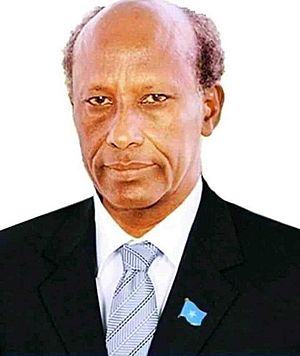Mohamed Farrah Aidid facts for kids
Quick facts for kids
Mohamed Farrah Aidid
|
|
|---|---|
| محمد فرح عيديد | |
 |
|
| Personal details | |
| Born | 15 December 1934 Galkayo, Italian Somalia |
| Died | 1 August 1996 (aged 61) Mogadishu, Somalia |
| Political party | United Somali Congress/Somali National Alliance (USC/SNA) |
| Spouse | Khadiga Gurhan |
| Alma mater | Frunze Military Academy |
Mohamed Farrah Aidid (born December 15, 1934 – died August 2, 1996) was a Somali leader. He was a general in the army and also worked as a diplomat. He led a group called the United Somali Congress (USC) and later the Somali National Alliance (SNA).
Aidid and other groups helped remove President Siad Barre from power in Somalia. This happened during the Somali Civil War in the early 1990s.
Later, the United Nations (UN) sent peacekeepers to Somalia. In June 1993, some UN peacekeepers were killed. Aidid and his group were blamed for this. The UN then tried to capture him.
After a raid in July 1993, Aidid's group started to target American soldiers. This led to a big battle in Mogadishu in October 1993. After this battle, the UN stopped trying to capture him.
Aidid died in Mogadishu on August 2, 1996.
Contents
Early Life and Military Career
Mohamed Farrah Aidid was born in 1934 in a place called Mudug in what was then Italian Somaliland. He belonged to the Habar Gidir clan.
He studied in Rome and Moscow. In the 1950s, he worked for the Italian colonial police force. Later, he joined the Somali National Army.
Aidid was a very smart and skilled officer. He was chosen to study advanced military science at the Frunze Military Academy in the Soviet Union. This was a top school for the best officers from many countries.
In 1969, a new government took over Somalia in a peaceful way. Aidid was a high-ranking army commander at the time. He was later put in prison for six years.
He was released to fight in the Ogaden War (1977–78) against Ethiopia. This war was about a disputed region called Ogaden.
After the war, he worked as an advisor to President Barre. He also served as Somalia's ambassador to India.
The Somali Civil War
After the Ogaden War, President Barre's government started to arrest many officials. They were suspected of trying to overthrow the government. Many people were killed, but some escaped the country. These people started groups to fight against Barre's rule.
By the late 1980s, many people in Somalia were unhappy with President Barre. His government became very strict. Groups fighting against him grew stronger, especially with help from Ethiopia.
This led to the start of the Somali Civil War. Barre's government was finally overthrown on January 26, 1991. After he left, many different groups started fighting for control of the country.
Two main groups, led by General Aidid and Ali Mahdi Mohamed, fought for power in the capital city, Mogadishu.
The United Nations in Somalia
Because of the civil war, the United Nations (UN) decided to help Somalia. They passed resolutions to create a peacekeeping mission called UNOSOM I.
Later, in December 1992, the UN approved a group of countries led by the United States. This group was called the Unified Task Force (UNITAF). Their job was to make sure the country was safe so that aid could reach people.
In 1993, the UN peacekeeping group started a new mission called United Nations Operation in Somalia II (UNOSOM II). This mission lasted for two years, mainly in southern Somalia.
Death
On July 24, 1996, Aidid and his men had a fight with forces led by his former allies, Ali Mahdi Muhammad and Osman Ali Atto. Atto had been a supporter and helped fund Aidid before.
Aidid was shot during this battle. He later died from a heart attack on August 2, 1996. This happened either during or after surgery to treat his injuries.
Family Life
During the civil war, Aidid's wife, Khadiga Gurhan, moved to Canada in 1989. She took their four children with her. She was granted legal resident status in Canada in June 1991.
Aidid's son, Hussein Mohamed Farrah, moved to the United States when he was 17. He lived there for 16 years and became a US citizen. He later joined the US Marines.
Hussein even served in Somalia. Two days after his father's death, Aidid's group, the Somali National Alliance, announced that Hussein was the new president. However, other countries did not recognize him as president.
See also
 In Spanish: Mohamed Farrah Aidid para niños
In Spanish: Mohamed Farrah Aidid para niños

